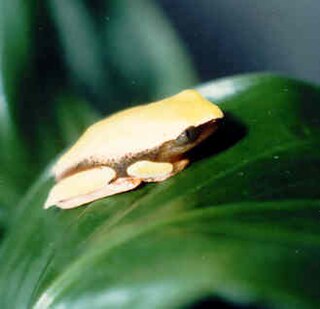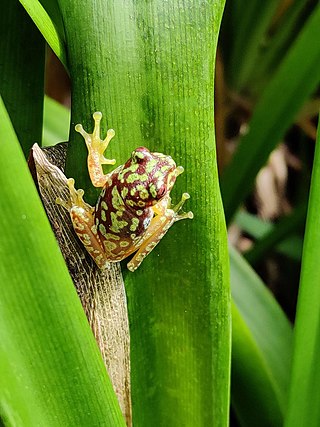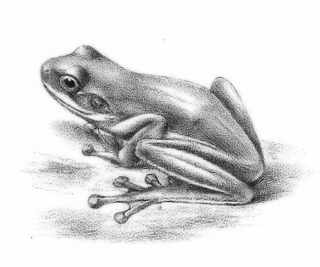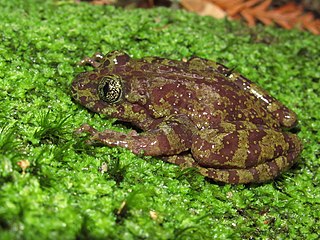
Phrynomedusa is a genus of tree frogs from the Southeast and South regions in Brazil. They were formerly considered to be part of the genus Phyllomedusa, as the "Phyllomedusa fimbriata group". Common names colored leaf frogs and monkey frogs have been coined for them.

The powdered glass frog or Chiriqui glass frog is a frog species in the glass frog family (Centrolenidae). The species is found from north-central Honduras south to northwestern Ecuador.

Allobates ornatus is a species of frog in the family Aromobatidae. It is endemic to northern Peru where it is only known from near its type locality, Tarapoto in the San Martín Province, on the eastern slopes of the Cordillera Oriental.

The Chamula mountain brook frog is a species of frog in the family Hylidae endemic to Chiapas, Mexico. Its natural habitats are moist montane forests. It is threatened by habitat destruction and has been rated as "endangered" by the IUCN.

The Copan brook frog is a species of frog in the family Hylidae found in northeastern Guatemala and northwestern Honduras, specifically in the Sierra del Merendón, Sierra de Omoa, Sierra de Caral, and Sierra Espíritu Santo ranges. The colouring of this species is very distinctive and the specific name soralia comes from the resemblance of its markings to the vegetative structures on some crustose lichens.

The Costa Rica brook frog or red-eyed stream frog is a species of frog in the family Hylidae found in Costa Rica and Panama. Its natural habitats are tropical moist lowland forests, subtropical or tropical moist montane forests, and rivers between 70 and 1740 meters above sea level.

Sarcohyla bistincta, also known as the Mexican fringe-limbed treefrog or Cope's streamside treefrog, is a species of frog in the family Hylidae. It is endemic to Mexico; it is widespread and occurs from southern Sinaloa and Durango southeastward to Veracruz and Oaxaca. The nominal Sarcohyla bistincta consists of several lineages that may eventually be described as distinct species.
Sarcohyla cyanomma, also known as the blue-eyed aquatic treefrog, is a species of frog in the family Hylidae. It is endemic to Mexico and only known from the northern slope of Cerro Pelón, in Sierra de Juárez in northern Oaxaca. It is feared that the species might be extinct.
Plectrohyla pokomchi is a species of frogs in the family Hylidae. It is endemic to central and eastern Guatemala and known from Sierra de Xucaneb and Sierra de las Minas at elevations of 1,400–1,900 m (4,600–6,200 ft) above sea level. Its specific name refers to the Poqomchi' people, a group of Indian people from the Guatemalan highlands. Common name Rio Sananja spikethumb frog has been coined for it.
Scinax danae is a species of frog in the family Hylidae. It is endemic to southeastern Venezuela and occurs in the La Escalera region of the Sierra de Lema, Bolívar state. The specific name danae honors Dana Trueb Duellman, the daughter William E. Duellman, the scientist who described this species. Despite this, common name Bolivar snouted treefrog has been coined for this species.
Leptopelis susanae is a species of frog in the family Arthroleptidae. It is endemic to southwest Ethiopia and known from the Gughe Mountains and Saja Forest. The specific name susanae honours Susan, the wife of the describer, Malcolm Largen. Common names Susan's tree frog and Susana's [sic] forest treefrog have been coined for this species.
Leptopelis yaldeni is a species of frog in the family Arthroleptidae. It is endemic to Ethiopia and occurs in the montane highlands in Gojjam. Its range might be limited by the deep gorges of the Blue Nile. It is named in honour of Derek Yalden, a British zoologist who collected some of the types. Common names Yalden's tree frog and grassland forest treefrog have been coined for this species.
Petropedetes palmipes is a species of frog in the family Petropedetidae. It is known from a few localities in southwestern Cameroon, Equatorial Guinea, and western Gabon. Common name Efulen water frog has been coined for it.

Philautus bunitus is a species of frog in the family Rhacophoridae. It is endemic to Malaysian Borneo and inhabits subtropical or tropical moist lowland forests and subtropical or tropical moist montane forests and is threatened by habitat loss.

Leptomantis angulirostris, commonly known as the masked tree frog, is a member of the tree frog family Rhacophoridae and is found in Indonesia and Malaysian Borneo. Its natural habitats are subtropical or tropical moist lowland forests, subtropical or tropical moist montane forests, and rivers. It is threatened by habitat loss.

Rose's ghost frog, or Table Mountain ghost frog, is a species of frog in the family Heleophrynidae endemic to South Africa. It is a medium-sized species with purple or brown blotches on a pale green background and large discs on its fingers and toes. It has a very restricted range, being only known from the slopes of parts of Table Mountain. The tadpoles live in permanent streams but these are in danger of drying up because of the establishment of pine plantations. Because of its small range and changes in its habitat, this frog is listed as critically endangered by the International Union for Conservation of Nature.
Papurana supragrisea is a species of true frog, family Ranidae. It is endemic to New Guinea, including some nearby islands. It is known with certainty only from southeastern New Guinea and from the D'Entrecasteaux Islands. However, this name has been used more broadly for a species complex that is widely distributed in the mountains of New Guinea. Common name Papua gray frog has been coined for it.

Rhacophorus kio is a species of flying frog in the family Rhacophoridae and is found in the rainforests of southeast Asia, in countries such as China, Laos, Thailand, and Vietnam. Its ability to glide and its adhesive toe pads make it well adapted to its habitat of the rainforest. Prior to a 2006 study by Annemarie Ohler and Magali Delorme, R. kio and R. reinwardtii were thought to be the same species. The common name black-webbed treefrog can refer to either species. Compared to other frog species in the area, R. kio not only creates a foam nest that holds their eggs, but also creates a structure with leaves that will wrap around the eggs. While the conservation status of the species is currently classified as of least concern by the IUCN Red List, R. kio faces habitat loss from deforestation to make space for agriculture and other human influences.
Cornufer citrinospilus is a species of frog in the family Ceratobatrachidae. It is endemic to the island of New Britain, Papua New Guinea, and is only known from the Nakanai Mountains of East New Britain Province. The specific name citrinospilus is derived from the Greek words kitrinos (="yellow") and pilos, in reference to the distinctive bright yellow flank areolations characteristic of this species.
Kurixalus absconditus is a species of frog in the family Rhacophoridae. It is endemic to West Kalimantan, in the Indonesian part of Borneo near the village of Piasak; it is likely to occur more widely. The specific name absconditus is Latin for "disguised", "concealed", or "hidden", and refers to this species remaining "undetected" within the Kurixalus appendiculatus group. Common name Piasak-frilled swamp treefrog, also spelled Piasak frilled swamp tree frog, has been coined for it.











